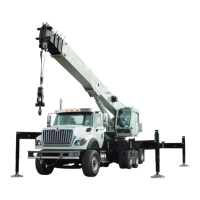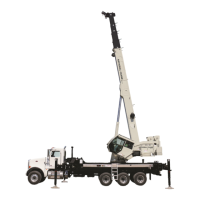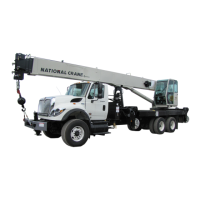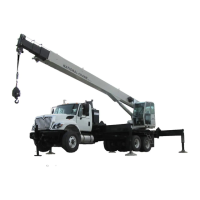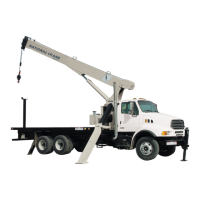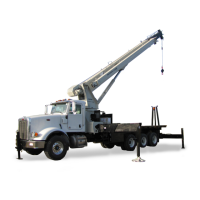Do you have a question about the Manitowoc NBT60XL and is the answer not in the manual?
| Brand | Manitowoc |
|---|---|
| Model | NBT60XL |
| Category | Construction Equipment |
| Language | English |
Provides an overview of the operator manual and its purpose for operating and maintaining the NBT60XL crane.
Details on additional manuals covering safety, operation, specifications, service, maintenance, and installation.
Instructions for new owners to register their crane with Manitowoc Crane Care for support.
Describes the terminology used for parts of the National Crane, used throughout the manual.
Explains the importance of safety messages, symbols, and signal words used in the manual.
Defines a qualified person and operator qualification requirements for safe crane operation.
Details operational aids like RCL systems, anti-two-block devices, and their proper use and maintenance.
Highlights the importance of a firm surface, proper outrigger setup, and load chart adherence for stability.
Explains the significance of load charts for determining allowable loads and safe lifting operations.
Discusses the impact of wind on lifting operations and provides guidance for safe operation in windy conditions.
Details hazards associated with operating near electrical power lines and preventative measures.
Provides information on synthetic and wire hoist ropes, including inspection and maintenance criteria.
Covers personal considerations, equipment access, job preparation, and safe working practices.
Outlines general guidelines for performing safe lifting operations with the crane.
Describes standardized hand signals for communication between the signal person and operator.
Provides safety information for erecting, stowing, and using the jib attachment.
Details procedures for safely parking and securing the equipment when unattended.
Offers precautions for operating the crane in cold weather conditions.
Provides a checklist for inspecting the boom sections for damage and wear.
Details inspection points for the superstructure to ensure structural integrity.
Outlines inspection procedures for the carrier components and chassis.
Describes the layout and function of all controls located within the crane cab.
Details the operation of outrigger controls from the cab and ground stations.
Identifies and describes the function of various crane control levers and switches in the cab.
Explains the operation of the foot pedal used for extending and retracting the boom.
Describes the Rated Capacity Limiter display and its functions for safe operation.
Details the location and function of switches used to override the RCL system.
Explains the function of the crane ignition switch for controlling engine and cab power.
Describes the operation of the single axis controller for boom lift and main hoist functions.
Explains the operation of the dual axis controller for boom lift and main hoist functions.
Provides essential steps for familiarizing with the crane and executing safe operating procedures.
Details daily checks required to ensure the crane is prepared for safe work operations.
Outlines procedures for safely stowing and parking the crane for travel or shutdown.
Emphasizes the importance of understanding and using load charts for safe lifting.
Provides general guidelines for performing a lift after the crane has been properly set up.
Details steps for shutting down the crane and preparing it for road travel.
Describes the standard hand-held radio remote control for setup and teardown operations.
Explains the functionality of the optional full crane remote control system.
Step-by-step instructions for activating and using the crane remote control.
Details how to override the RCL system using key switches and the associated cautions.
Explains how to set operational limits to restrict crane movement to defined areas.
Lists tasks available in the Tools menu, including settings and calibration.
Guides the user through accessing and performing system configuration tasks.
Details the process and circumstances for calibrating RCL sensors.
Provides information on accessing and interpreting crane and truck diagnostic data.
Explains how to interpret active and logged faults and real-time component status.
Covers procedures for proper leveling, site selection, and setting the outriggers.
Provides critical safety information and guidelines for operating with the jib attached.
Details the procedures for safely erecting and stowing the jib.
Explains how to deploy and stow the different jib types supported by the NBT60XL.
Describes the correct procedure for installing the anti-two-block weight for safety.
Explains multi-part line reeving for increased load capacity and its limitations.
Specifies the crane's rated load capacity and conditions for lifting the maximum load.
Provides a step-by-step guide for properly installing wire rope onto the hoist drum.
Covers the types of wedge sockets and procedures for their correct installation.
Details the procedure for mounting, stowing, and using removable counterweights for stability.
Step-by-step instructions for mounting the top counterweight section onto the crane superstructure.
Procedure for safely stowing the top counterweight onto the carrier deck.
Instructions for mounting the bottom counterweight sections onto the crane.
Provides guidance on selecting appropriate lubricants based on operating conditions and temperature.
Details the importance of selecting the correct hydraulic oil for system performance and life.
Lists and describes lubrication points, intervals, and recommended lubricants for crane components.
Instructions for lubricating internal cable sheaves, including required tools.
Covers inspection, replacement, and draining procedures for hoist gearbox and brake oil.
Details the recommended procedure and intervals for changing swing gearbox oil.
Explains the importance of wire rope lubrication for reducing friction and preventing corrosion.
Provides guidelines for washing and cleaning the crane to protect its finish and prevent corrosion.
Outlines regularly scheduled inspection and maintenance intervals for peak operating condition.
Details frequent, periodic, and yearly inspections for hoist rope condition and safety.
Provides criteria and guidelines for determining when wire rope needs replacement.
Covers maintenance aspects of the hydraulic system, including the oil cooler.
Indicates proper tire inflation pressures based on load for stability, comfort, and tire life.
Lists technical specifications for the crane's hydraulic, air conditioning, hoist, and other systems.
Explains the purpose and components of the Rated Capacity Limiter (RCL) system.
Describes the Main Menu screen, function keys, and how to interpret RCL display information.
Explains warning icons for RCL and ATB overrides, emphasizing caution when bypassed.
Details the required steps to enter lifting configuration into the RCL system before operation.
Describes how to access and interpret the RCL Operating Mode screen and its parameters.
Guides on setting operational limits like slew angle, WADS, boom angle, tip height, and radius.
Lists functions within the Tools menu, including units of measure, joystick settings, and reminders.
Explains how to access system configuration for calibration, software updates, and settings.
Provides procedures for calibrating RCL sensors when readings are inaccurate or components are replaced.
Details how to access and interpret diagnostic information, fault codes, and real-time I/O data.
Explains how to interpret fault codes and real-time component status for troubleshooting.





